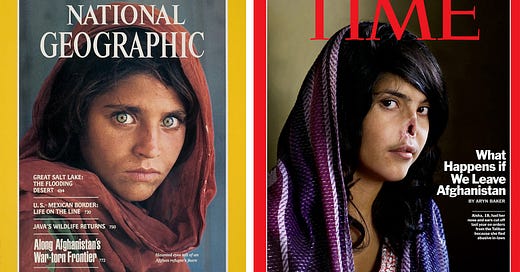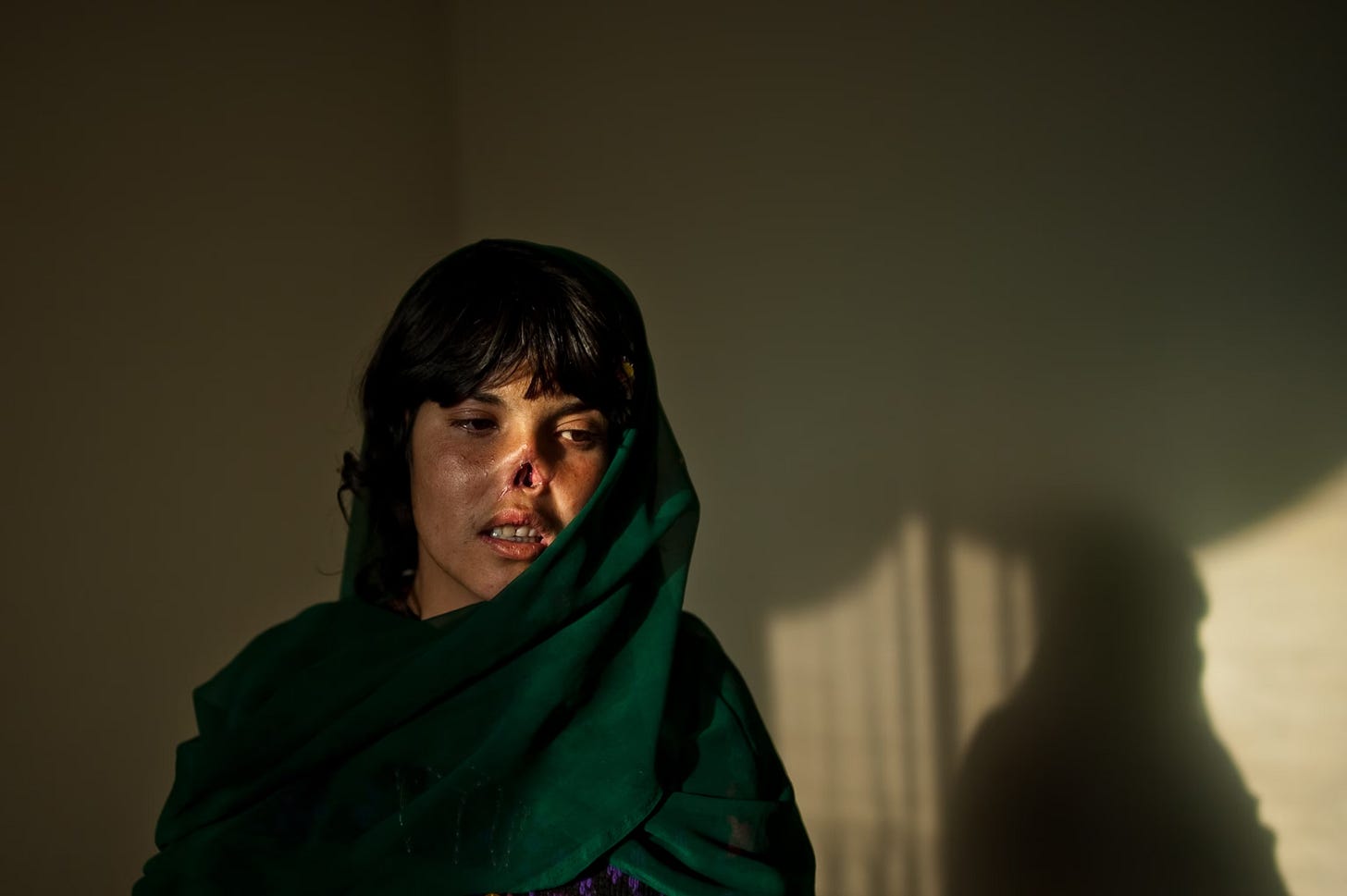The Other Afghan Girl, Revisited
Two iconic magazine covers, 25 years apart, forever connected.
The June 1985 cover of National Geographic, photographed by Steve McCurry, and the August 9, 2010, cover of TIME, photographed by Jodi Bieber, are two of the most well-known magazine covers in history — instantly recognizable, highly controversial, and forever connected.
Little else can be said on McCurry’s photo of Sharbat Gula, the Afghan girl with the “piercing eyes” and a “penetrative gaze” who has captivated the world for decades. It’s perhaps the most famous photo ever taken, and one of the most condemned (largely by other photographers).
Yet, McCurry’s iconic photo didn’t make “the tray” — the final selection of slides presented to the magazine’s top editor. “There was another frame that National Geographic was going to use,” McCurry recalled in his 2013 book, Untold: The Stories Behind the Photographs.
Taken just before the iconic portrait, the photo is playful, far less dramatic, certainly less “haunting.”
“She had a her hands up to her face but the light was still not quite right. And that kind of connection still wasn’t as strong as I wanted it to be.” McCurry explained in this video from 2010. He said the teacher asked Sharbat Gula to relax, explaining to her the importance of spreading the word of their conditions as refugees in the camp.
Sharbat Gula said in a 2017 interview that she was 10 years old when McCurry took her photo (it was originally believed she was 12).
“She dropped her hands, the light was right…she looked directly into my lens and for literally just two exposures, just two frames, I got this really concentrated, focused, very intense look on her face and then it was gone.”
McCurry’s photo editor at National Geographic originally passed on the now-iconic portrait, calling it “too disturbing.” They compromised and showed both of the photos. McCurry recalled, “As soon as the editor (Bill Garrett) saw this he literally leapt to his feet and said, ‘There’s our next cover.’”
And for those of you that want to know, McCurry made the photo of the Afghan girl on Kodachrome 64 film with a Nikon FM2 and 105mm lens.
There were no online galleries in 1985 or social media, obviously. I believe context is important — so this is how the story appeared in the June 1985 edition of National Geographic.
In 2002, seventeen years after National Geographic published the Afghan girl cover, National Geographic Television and McCurry traveled to Pakistan and found Sharbat Gula, which led to this film, this story, and this meta magazine cover.
I found the iris examination stunt used to confirm her identity as the “Afghan girl” insensitive and unnecessary. It’s painful to watch.
Sharbat Gula now lives in Italy, forced to flee Afghanistan after the Taliban took control in 2021. She was interviewed in 2022 by the Italian news magazine Il Venerdì and photographed in her apartment in a “quiet corner of Italy” by Luigi Narici — a challenging assignment indeed.

“That photo created a lot of problems for me,” Sharbat Gula told Il Venerdì, “I would have preferred it had never been taken. I remember that day well, that photographer who arrived at the Nasir Bagh camp school. I was a child. I didn't like photos. In Afghan culture women do not appear in photos. But there wasn't much choice.”
That’s a strong, damning quote. But, sometimes quotes are cherry-picked and edited to fulfill a predetermined narrative.
I say that because I just watched Denis Delestrac’s 2023 documentary “McCurry: The Pursuit of Color.” Sharbat Gula makes an appearance. She says in the film:
“At the beginning I hated the photo and the attention. Now I am very happy. The picture earned me respect and made me very popular. The income from the photo has helped widows and orphans and helpless people. Now I am proud of it. I pray to Allah for peace in my country so that no one shall ever become a refugee.”
I thought of McCurry’s “Afghan girl” the moment Jodi Bieber’s shocking photo of Bibi Aisha appeared on my screen at TIME magazine on July 20, 2010. I was TIME’s International Picture Editor then and had commissioned Bieber, a South African photographer, to make a series of portraits of Afghan women.
TIME’s Kabul bureau chief, Aryn Baker, wrote the cover story and was instrumental in finding the women Bieber photographed. Bibi Aisha, an 18-year-old woman whose nose and ears were brutally cut off by the Taliban as punishment for fleeing her abusive in-laws, was one of those women.
We were speechless.
Bieber spent about three hours with Bibi Aisha at a women’s shelter in Kabul.
“I could have made a photograph with her looking or being portrayed more as the victim, and I thought, no, this woman is beautiful,” Bieber told TIME.
“Her headscarf fell slightly back and her hair was exposed, and she had the most beautiful hair, and I said to her, ‘You know, you are really such a beautiful woman, and I could never understand or know how you’re feeling…but what I can do is show you as beautiful in this photograph.’”
During a speech in Johannesburg in 2013, Bieber recalled the moment she took the photo: “I said, ‘close your eyes, try just for one minute put behind you what happened, and think of your inner beauty and inner strength.’ She opened her eyes and that’s when I took this photograph.”
And again, for those of you who care, Bieber made the photo of Bibi Aisha with a Nikon D3 and an 85mm lens.
Part of my role as a photo editor at TIME was making decisions between photos — slight variations in light, composition, and timing can make an enormous difference. But with Bieber’s shoot, there were no decisions to be made. She sent us two photos of Bibi Aisha, the now-iconic photo and one other environmental portrait (see layout below). We didn’t have an alternative, nor did we want one.
Kira Pollack, the Director of Photography of TIME in 2010, strongly advocated for the photo to appear on the cover, as did I. But similar to McCurry’s photo, the final decision rested with TIME’s editor in chief, Richard Stengel.
“I thought long and hard about whether to put this image on the cover of TIME,” Stengel wrote. “In the end, I felt that the image is a window into the reality of what is happening — and what can happen — in a war that affects and involves all of us. I would rather confront readers with the Taliban's treatment of women than ignore it.”
The confusing headline, “What Happens If We Leave Afghanistan,” nearly overshadowed Bieber’s heartbreaking photo and Baker’s wonderfully told story about the plight of Afghan women in Kabul. That headline, curiously missing a question mark, ignited debate and received far more criticism than the photo, which went on to win the coveted World Press Photo of the Year award in 2011.
There were instant comparisons to McCurry’s Afghan girl photo. Bieber acknowledged she referenced McCurry’s photo in this interview with World Press Photo. “It definitely was part of how I chose to photograph Aisha,” she said.
Bieber wasn’t in Afghanistan to photograph one woman, the image of Bibi Aisha was part of a larger portfolio. Here is how the story appeared in print. It’s fascinating to the see the difference in design and scale from McCurry’s National Geographic piece. 26 pages in 1985 vs. 8 pages in 2010.
Bieber and I visited Bibi Aisha in Queens, New York, in 2012. It was a surreal, unforgettable experience. Bibi Aisha was apprehensive at first, but once she remembered Bieber, her whole demeanor brightened. She smiled, then embraced Bieber. It was a beautiful moment.
Ironically, Lynsey Addario had previously photographed Bibi Aisha for National Geographic. Addario’s stark, dramatically-lit photo appeared in the December 2010 issue.
Kate Brooks also photographed Bibi Aisha; the image appeared in The Wall Street Journal on August 3, 2010. Brooks’ image is more subtle than the others, Bibi Aisha’s face is partially obscured but the horrific detail remains.
The New York Times did a follow on the TIME cover with this malicious lede: “She cannot read or write and had never heard of Time magazine until a visitor brought her a copy of this week’s issue, the one with the cover picture of her face, the face with no nose.”
The Times article by Rod Nordland was accompanied by an image taken by Eros Hoagland, who photographed Bibi Aisha in a women’s shelter in Kabul on August 4, 2010, just before she left for the United States.
Stephanie Sinclair also photographed Bibi Aisha. This beautiful, dream-like portrait was part of Sinclair’s phenomenal global project, “Too Young To Wed,” now a non-profit organization with the mission to empower girls and end child marriage (donate to the TYTW Afghanistan Emergency Initiative here).
TIME turned 100 last week (the occasion that inspired this piece) and is revisiting historic covers from the past, including their controversial Afghanistan cover.
TIME commissioned Sinclair to photograph Bibi Aisha again, this time at her home in Maryland. The result is simple, yet stunning.
“I want to become a nurse to help people,” Bibi Aisha told Angelina Jolie in the new issue of TIME. “I want to help people who are hurting and say to them, if I could get through my darkest hours, you can.”





















thanks for sensitively sharing the stories behind the photos of these brave and courageous women.